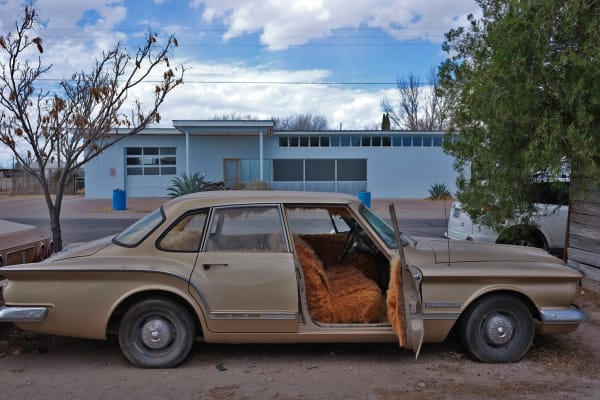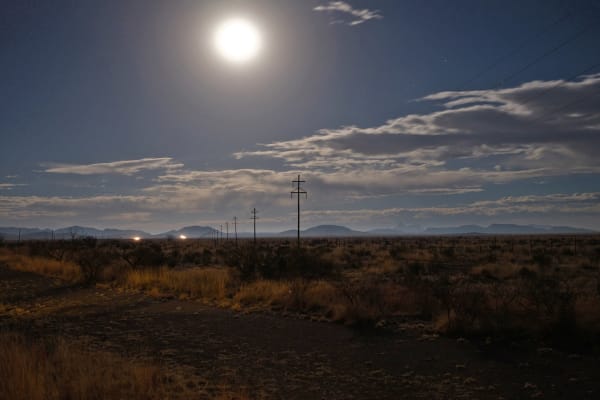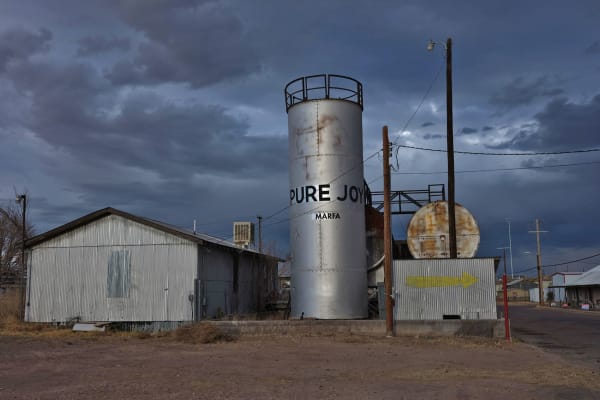Miguel Soler-Roig: Marfa Lights
Past exhibition
Overview
Barbara Davis Gallery is pleased to announce Marfa Lights, a solo exhibition by artist Miguel Soler-Roig. This is his fourth exhibition at the gallery, marked by his participation in this year's Venice Biennale.
"I have always been struck by the peculiarity of the American landscape for its incomparable vastness, free of shadows and interruptions. This has to do with the sun, with its possibility of expansion, of flooding everything thanks to a liberated luminosity." - Miguel Soler-Roig
At the Marfa Center, all the resident artists agree in highlighting the enormous influence that the environment has on their work and their experiences. Miguel Soler-Roig has understood similar themes in artistic residencies such as the NMAC Foundation (Montenmedio Contemporary Art Center) in Cadiz in the summer of 2014, a unique open-air museum space in Spain that also establishes a dialogue between contemporary art and nature in perfect harmony. A remarkable collection of outdoor sculptures and installations has been consolidated, with creators as important as James Turrell and Marina Abramovic.
In Marfa, he again imbues himself in a powerful natural atmosphere that is loaded with history and cultural references. The environment influences his photographs, his method, and his emotional state. The images show us the silence, the coldness and desolation of the city when it is deprived of artistic activity. The radiant light of the desert hits the empty streets, the austere buildings and the varied angles of concrete sculptures completely integrated into the landscape. All sense of spatial limit is lost, like the Texan horizon.
"Through this landscape I felt I let myself go. I let go of the reins of my gaze until I reached a meditative state — everything was calm, like an imperturbable horizon. The path was defined by gradually approaching the west, with its corresponding consequences, both material and symbolic. On the one hand, as I advanced, civilization was disappearing; from the most populated towns in Texas — Houston, Austin, San Antonio — to less inhabited ones in the border of Mexico near the Amistad Dam, it all faded away.
What I depict here is the broad phenomenon that celebrates Americana while simultaneously providing some of the harshest criticisms of this country. The questions in trying to understand what Americana is remain rhetorical in most cases. The answers could be found deep in your heart, or perhaps in this small town in Texas, which explains the love for the country and the need to preserve its identity and history. My artistic interpretation should be seen as a vehicle that conveys cultural identity filled with different metaphors and memories, speaking to the trajectory of American history and all the amazing and beautiful things that most of us recognize and love.
To sum up my work in this part of the American Southwest I can quote Georgia O’Keeffe: “Such a beautiful, untouched lonely feeling place, such a fine part of what I call the ‘Faraway’. It is a place I have painted before... even now I must do it again.”"
-Miguel Soler-Roig
"I have always been struck by the peculiarity of the American landscape for its incomparable vastness, free of shadows and interruptions. This has to do with the sun, with its possibility of expansion, of flooding everything thanks to a liberated luminosity." - Miguel Soler-Roig
At the Marfa Center, all the resident artists agree in highlighting the enormous influence that the environment has on their work and their experiences. Miguel Soler-Roig has understood similar themes in artistic residencies such as the NMAC Foundation (Montenmedio Contemporary Art Center) in Cadiz in the summer of 2014, a unique open-air museum space in Spain that also establishes a dialogue between contemporary art and nature in perfect harmony. A remarkable collection of outdoor sculptures and installations has been consolidated, with creators as important as James Turrell and Marina Abramovic.
In Marfa, he again imbues himself in a powerful natural atmosphere that is loaded with history and cultural references. The environment influences his photographs, his method, and his emotional state. The images show us the silence, the coldness and desolation of the city when it is deprived of artistic activity. The radiant light of the desert hits the empty streets, the austere buildings and the varied angles of concrete sculptures completely integrated into the landscape. All sense of spatial limit is lost, like the Texan horizon.
"Through this landscape I felt I let myself go. I let go of the reins of my gaze until I reached a meditative state — everything was calm, like an imperturbable horizon. The path was defined by gradually approaching the west, with its corresponding consequences, both material and symbolic. On the one hand, as I advanced, civilization was disappearing; from the most populated towns in Texas — Houston, Austin, San Antonio — to less inhabited ones in the border of Mexico near the Amistad Dam, it all faded away.
What I depict here is the broad phenomenon that celebrates Americana while simultaneously providing some of the harshest criticisms of this country. The questions in trying to understand what Americana is remain rhetorical in most cases. The answers could be found deep in your heart, or perhaps in this small town in Texas, which explains the love for the country and the need to preserve its identity and history. My artistic interpretation should be seen as a vehicle that conveys cultural identity filled with different metaphors and memories, speaking to the trajectory of American history and all the amazing and beautiful things that most of us recognize and love.
To sum up my work in this part of the American Southwest I can quote Georgia O’Keeffe: “Such a beautiful, untouched lonely feeling place, such a fine part of what I call the ‘Faraway’. It is a place I have painted before... even now I must do it again.”"
-Miguel Soler-Roig
Works





